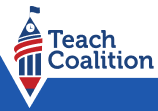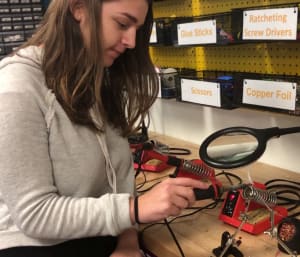With more than 2 million unfilled STEM jobs projected for the U.S. economy by 2027, STEM education has become an essential priority in developing the workforce of our future — especially engaging young women and girls who remain underrepresented in STEM fields.
The reality, however, is that STEM education is costly – not only for the purchase of equipment and materials, but also teachers.
STEM teachers remain in short supply. This is driving up costs for many nonpublic schools, where families are already making major financial sacrifices to provide education for their children that meets their religious and cultural needs.
But help is on its way.
Teach NJ, the statewide affiliate of Teach Coalition, has been a leading voice in advocating for increased government funding to support STEM education in nonpublic schools. Last year, Governor Phil Murphy signed into law a new, first-of-its-kind grant program that will compensate public-school STEM teachers who teach one or more nonpublic school classes during either regular school hours or after school.
Applications for this program are now available. We recently caught up with Gila Stein, Director of STEAM Education and Innovation (the “A” stands for Arts) and science department chair at Ma’ayanot High School, in Teaneck, to discuss how this all-girls yeshiva has built a cutting-edge program, why it’s so critical, and the challenges she’s faced.
Can you tell me why STEM education is important and why it is especially important trend in Jewish Education — specifically secondary schools?
Today’s workforce is more technologically sophisticated than ever before. Seventy-five percent of the fastest growing occupations in the U.S. workforce require significant mathematics or science skills. Therefore, to optimally succeed in the 21st century job market, today’s high school students must be equipped with a digital skillset that fosters creative problem-solving and innovation. Anything less will hamper their ability to achieve at the highest professional levels.
Could you provide a little history about the background of STEM at Ma’ayanot and how it has evolved?
Four years ago, we launched a new STEAM program designed to ensure that ALL Ma’ayanot students graduate with a comprehensive understanding of computer science and engineering skills and competencies. Before this, we had offered a single engineering elective chosen by self-selecting students. Our current inclusive approach, requires all students to complete a two-year course in the foundations of robotics, engineering, computer science, and fabrication. Students can then choose to enhance their foundations in STEAM with a multitude of 11th and 12th grade electives in STEAM. We also built a state-of-the-art makerspace in order for our STEAM students to have the necessary equipment and setting in which to collaborate and innovate.
Our program is called STEAM because STEM stands for Science, Technology, Engineering, and Math and we put the “A” for Arts – to include the creative and artistic applications of these subjects. Whether it’s called STEM or STEAM, the key is to create a program that inspires and prepares students at all academic levels to be innovators and to confidently engage in STEAM experimentation.
Why do you think it’s important for young Jewish girls, specifically, to be at the forefront of movement for more women to become leaders in STEM fields?
One of the core values of Judaism is social responsibility, and by using STEAM to impact the community, we are implementing what we are teaching our students in the classroom. One example of this is our “Better Together Program.” Our sophomore STEAM students visit residents of the Jewish Home at Rockleigh throughout the year, discuss their needs and different abilities, and created new, innovative assistive devices for senior citizens in our school’s state-of-the-art makerspace. One example was a motorized device designed to teach Hebrew braille, inspired by Jewish Home resident Charlotte Poole and created by a team of Ma’ayanot sophomores.
There is a clear gender gap that discourages women from entering STEAM related fields. We want our students to know that if they set their minds to something, they can do it. We want them to be completely empowered.
So what were some of the challenges that you faced in getting your program ramped up and launched and in the day to day running of the program?
Finding and hiring teachers who are both knowledgeable in science, engineering, and computer science, and skilled at teaching these subjects, is a daunting task. In addition, continual professional development is needed in order to prepare students with the skill-set they need to participate and become leaders in a fast-paced technology-driven workforce that is constantly changing and evolving. The funds required for this type of staffing and continuing professional development are quite extensive. In addition, building a fully equipped maker space for our STEAM classes was itself a large undertaking. We are constantly looking for new sources of funding in order to be able to continue to enhance and grow our program.
What was your solution in terms of getting the right teachers? Did you need to hire more teachers or did you need to send the teachers you have to trainings? How did you go about scaling your capacity in terms of instruction in teachers specifically?
We did both. For example, our director of STEAM curriculum, Mrs. Reyce Krause is a former math teacher who spent a great deal of time with consultants and engineers, learning the skills she needed to craft a cutting-edge STEAM curriculum. We also hired an engineer to be our in-house STEAM consultant.
Great, what about the state level grants? Have you had success in that type of money?
We have primarily received funding from private grants. We recently got a big grant from the Gottesman Foundation, which is helping fund the renovation and expansion of our science labs and STEAM classrooms. For girls, it should be easier to get state grants – but because we are a private school there is currently not a lot of funding available from the government.
And do you plan to pursue some of the new government grants that are materializing as result in part of the work that Teach NJ is doing at the state level?
Definitely. We are very excited to hear that there will be some government grants available to private schools because this is an area that we haven’t been able to tap into. Having a new opportunity to increase the funding that will be available for our STEAM program is very exciting. We look forward to getting more information about it and receiving guidance on how to apply for it.
The response has been very, very positive. First of all, when current and prospective parents come to see our maker space, they are thrilled by the collaboration and innovation that is occurring there. The students love the class because it is a project-based class in which they can create, code, and fabricate. Everyone is really excited about the accomplishments of our STEAM program and the impact they have had on our students and the broader Ma’ayanot community.


